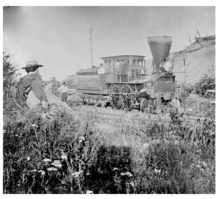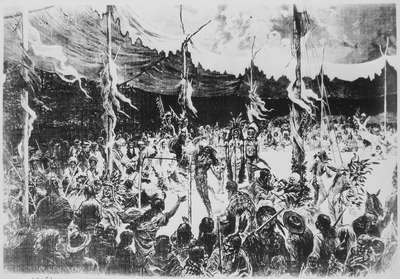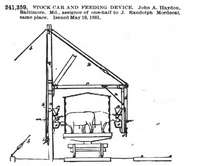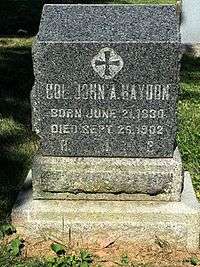John A. Haydon
| John A. Haydon | |
|---|---|
| Born |
June 21, 1830 Alexandra, Virginia, United States |
| Died |
September 26, 1902 (aged 72) Frederick, Frederick County, Maryland, United States |
| Residence | United States |
| Nationality | American |
| Occupation | surveyor, civil engineer, Railroad executive |
John A. Haydon (1830 – 1902) was a prominent American surveyor and civil engineer. As a self-taught civil engineer, Haydon made significant contributions to American railroading. Haydon's railroad career spanned the Baltimore and Ohio railroad expansion to the Ohio river in 1853 and several other railroads to the last transcontinental railroad, the Northern Pacific railway. Haydon led the 1872 Yellowstone River expedition, where he faced a Sioux Indian skirmish led by Sitting Bull, Red Cloud and Crazy Horse at the Battle of Pryor's Creek, Montana. He also served as a captain in the Confederate army Corps of Engineers under Generals Tilghman and Beauregard; captured at the battle of Fort Henry, early in the Civil War in 1862, he was paroled at Alton, South Carolina, in 1863 to serve the rest of the war, including the Richmond–Petersburg Campaign. In the later part of his life, he worked locating branch railroads for the Western Maryland railroad.
Early life and career
Haydon was born on June 21, 1830, in Alexandra, Virginia. [1] [2]
Baltimore and Ohio Railroad

Orange and Alexandria Railroad
Haydon worked on the construction of the Orange and Alexandria Railroad middle section and Warrenton, Virginia branch as one of three resident engineers. [3]
Civil War service
Haydon lived in Nashville, Tennessee, in 1860, giving his occupation as civil engineer. [4] and enlisted in the Confederate Corps of Engineers when the war broke out in 1861. [5] [6] He was captured the next year with the surrender of Fort Henry on February 6, 1862.[6] He was sent to Johnson's Island in Ohio, at that time, a prisoner-of-war camp for Confederate officers, the only Union prison exclusively for Southern officers. Haydon was paroled in May 1863 and returned to service and surrendered as part of General Johnson's Army on April 26, 1865. [6] [7]
Frederick and Pennsylvania Line Railroad

In 1868, Haydon became chief engineer of the Frederick and Pennsylvania Line Railroad in Frederick, Maryland. Haydon completed construction of the railroad in June, 1872.[Minutes 1][8]
Northern Pacific Railway
As of summer 1871, the railroad had only surveyed its route from Duluth, Minnesota westward to Bismarck, North Dakota. On the Western leg, the railroad had been located from Tacoma, Washington east to Bozeman, Montana. This left chief engineer William Milnor Roberts with the task of locating over 600 miles of railroad in Western Dakota and Eastern Montana
[6] what was known at that time as the "middle division" of the Northern Pacific.
[9]
Roberts planned surveys that included crossing the Bitterroot Mountain passes into Missoula, Montana, as well as a Yellowstone River survey.[6] Robert's plan was for this last survey to start at Fort Ellis, a United States Army fort, east of present-day Bozeman, Montana, cross over Bozeman Pass and follow the Yellowstone River down stream.[6] Roberts chose Edward D. Muhlenberg to head up this 1871 railroad survey party for the Yellowstone River portion.[6] Muhlenberg ran into numerous difficulties executing the plan and producing maps. In November 1871, Roberts joined the effort and reached Muhlenberg's camp on November 8, 1871. Roberts continued the survey to the edge of the Lakota hunting grounds near Pompey's pillar on November 11, returning to fort Ellis on November 20, 1871.[6] Muhlenberg, however, didn't return until November 28, where the military escort under Captain Edward Ball reported 57 soldiers injured by freezing weather.[6] The same winter storm trapped 65 men in another army unit, the 7th infantry, resulting in 22 amputations.[6]
- (Another Hayden, Ferdinand Vandeveer Hayden had made an earlier survey of the Yellowstone River as part of the 1871 Western surveying expedition.)
The following year, 1872, Roberts was not able to start recruiting for the 1872 Western survey until June.[6] Haydon had just completed the construction of the Frederick and Pennsylvania Line Railroad and was hired by Roberts. In July 23, 1872, Haydon led the railroad survey party from Fort Ellis, a United States Army fort, east of present-day Bozeman, Montana, consisting of Haydon, chief of party, two principal assistants, in charge of the compass and level, together with rodmen, chainmen, and others (altogether 20 men).[6] Haydon supply train consisted of almost seventy wagons with rations for 105 days and a small herd of beef cattle.[6] Haydon's military escort, commanded by Major Eugene Baker, Second Cavalry, consisting of four companies, 187 men, of the Second Cavalry, and four companies, 189 men, of the Seventh Infantry.[6]
Haydon's mission was to follow the Yellowstone River down stream to the mouth of Powder River a distance of 310 miles. Haydon to meet up with another survey party coming in from Fort Rice in North Dakota on the Missouri river, a distance of over 240 miles to Powder river.[10]
Haydon was to return from the Powder via the Musselshell River following this river to its source.[11]
The survey party and military escort proceeded without the benefit of Crow Indian scouts, largely due to rumors of a Sioux-Cheyenne attack or preparations for multiple river crossings with ferry boats.[6] Given these difficulties, Haydon had progressed only 155 miles from Fort Ellis, he was still short 125 miles of his destination of the Powder and had not yet gone beyond where Muhlenberg had finished the year before.[6]

Battle of Pryor's Creek, Montana
On August 13, there were as many as two thousand lodges of Lakotas, Cheyennes, Arapahos and Kiowas gathered on the Powder river under Sitting Bull, Red Cloud and Crazy horse. After performing an annual sun dance ceremony,[12]
a war party was formed with as many as a thousand warriors to go upstream on the Powder to locate and fight their enemy, the Crows.[6] The peace treaty of Fort Laramie of 1868 was still in effect, but Sitting Bull found himself just miles from hundreds of horses and cattle and the railroad surveyors led by John Haydon.[6] Sitting Bull attacked in the early hours of August 14, 1872, but by mid-morning the attack was over. During the battle, Sitting Bull in a personal show of bravery, took four others with him to within two hundred yards of Baker's forces and sat down with pipe and tobacco. He was untouched by any of the soldiers' shots. In similar manner, Crazy Horse mounted a pony and rode in front of the soldiers only to have his horse shot out from underneath of him. By eight o'clock in the morning, the battle was over. No one in Haydon's party was hurt, and that afternoon Haydon's party surveyed another three miles.[6] Haydon, as a Confederate officer who fought and then had to surrender in an untenable military battle (the battle of Fort Henry, Tennessee, February 6, 1862) realized that his party was probably outnumbered by the Sioux and Cheyenne and led by an individual with a questionable military command ability. Although they continued on until August 18, at time, Haydon, exhausted and apprehensive about the safety of the survey party from raids as well as knowing his work with the railroad was ended, requested Baker to return to Fort Ellis.[6] Sitting Bull's defeat had become a strategic victory.[6] For the Northern Pacific railroad, it was a "...stinging, unmitigated defeat, more damaging than any other event to date." (NPR Asst. Superintendent R. A. Crofton, 1873 letter cited in Lubetkin.) [6]
The pattern repeated itself in the Yellowstone Expedition of 1873, resulting in the battles of Honsinger Bluff and Pease Bottom.[6] Full-scale war might have come to the northern plains in 1873 had the Northern Pacific railroad surveys been successful.[13]

Return to Fort Ellis
On August 20, 1872, Haydon's party left the Yellowstone River to march towards the Mussellshell river as planned by Chief Engineer Roberts. Haydon became ill on the trip and was temporarily replaced by Lt. Edward John McClernand, who studied surveying at West Point.[6] With Haydon resuming as party chief, the surveyors reached the south fork, 20 miles west of Harlowton, Montana, on September 15. Over the next two weeks, marching through snow and bitter cold, Haydon's party crossed over the pass separating the Mussellshell from the Missouri river by way of Sixteen Mile Creek. On September 26, Baker left Haydon, who went on to the NPR's offices in Helena, thus ending the 1872 Yellowstone expedition and survey.[6]
Unlike the other 1872 NPR survey party leader, Thomas Rosser, who was also a former Confederate officer and fellow engineer under General Beauregard, Haydon didn't have Rosser's experience in cavalry raids or efficiency in handling combat troops. Baker, unlike the other military escort commanders, Ball, Whistler and Stanley, moved his camp only once after the August 14 skirmish. Baker's refusal to furnish more than one company of soldiers to support Haydon in the face of a large Sioux force forced Haydon to turn back. Shortly after Baker returned to Fort Ellis, General Hancock placed him under arrest.[6]

Patents
Haydon received two patents for his work:
- Patent No. 241,359 in 1881 for a stock car feeding device.[14][15]
- Patent No. 185,795 in 1876 for an roadway pavement consisting of a stone substratum, formed by slabs set into the road-bed at an angle, an intermediate layer, of concrete and a top dressing.[16]
Death
Haydon died in Frederick, Maryland, on September 26, 1902, and is interred in St. John's cemetery in Frederick.[1][17]
References
- 1 2 "Find A Grave Index," database, FamilySearch (https://familysearch.org/ark:/61903/1:1:QVV7-Z12W : 13 December 2015), John A Haydon, 1902; Burial, Frederick, Frederick, Maryland, United States of America, Saint Johns Cemetery; John A Haydon at Find a Grave.
- ↑ "United States Census, 1900," database with images, FamilySearch (https://familysearch.org/ark:/61903/1:1:M32Q-4NK : 20 January 2015), John A Haydon, Frederick city (north part), Frederick, Maryland, United States; citing sheet 10A, family 219, NARA microfilm publication T623 (Washington, D.C.: National Archives and Records Administration, n.d.); FHL microfilm 1,240,622.
- ↑ Virginia., & Virginia. (1852). Annual reports of officers, boards, and institutions of the Commonwealth of Virginia, for the year ending September 30. Richmond: Supt. of Public Printing.
- ↑ United States Census, 1860", database with images, FamilySearch (https://familysearch.org/ark:/61903/1:1:M8YM-Q4R : 30 December 2015), John A Hayden, 1860.
- ↑ United States Civil War Unfiled Papers of Confederate Soldiers, 1861–1865," database, FamilySearch (https://familysearch.org/ark:/61903/1:1:VQZF-7YQ : 4 December 2014), John A Haydon, ; from "Unfiled Papers and Slips Belonging to Confederate Compiled Service Records," database, Fold3.com (http://www.fold3.com : 2010); citing NARA microfilm publication M347 (Washington, D.C.: National Archives and Records Administration, 1962), roll 177.
- 1 2 3 4 5 6 7 8 9 10 11 12 13 14 15 16 17 18 19 20 21 22 23 24 25 26 Lubetkin, M. John (2006). Jay Cooke's Gamble-The Northern Pacific Railroad, the Sioux and the Panic of 1873. Norman, OK: University of Oklahoma Press. pp. 131–33. ISBN 0-8061-3740-1.
- ↑ Thomas, J. W. 1855–1926.page 331 (1969). History of Allegany County, Maryland, Baltimore: Regional Pub. Co. Accessed at
- ↑ Coverdale & Colpitts (1945). "The Pennsylvania Railroad Company: The Corporate, Financial and Construction History of Lines Owned, Operated and Controlled To December 31, 1945". Philadelphia, PA: Allen, Lane & Scott. p. 469.
- ↑ "Northern Pacific Railroad". Puget Sound Dispatch. Washington State. July 25, 1872. Retrieved July 8, 2016.
- ↑ General Hancock, in his 1872 annual report stated: “On the 29th of June I received instructions from (General Sheridan) to prepare two commands as escorts for two surveying parties of the Northern Pacific Railroad, one to proceed from Fort Rice on the Missouri River about 240 miles and return, the other to start from Fort Ellis, Montana, proceed to the mouth of Powder river, 310 miles, and then return by way of the Mussellshell river.” Source:
- ↑ Lubetkin, M. John, ed. Frontier Military Series : Before Custer : Surveying the Yellowstone, 1872. Norman, US: University of Oklahoma Press, 2015. ProQuest ebrary. Web. 8 July 2016.
- ↑ Vestal, Stanley. Warpath: The True Story of the Fighting Sioux Told in a Biography of Chief White Bull. U of Nebraska Press, page 137,1934. Accessed on July 11, 2016.
- ↑ Hutton, Paul Andrew. Phil Sheridan and his army, page 286. University of Oklahoma Press, 2013.
- ↑ The Railway Age Monthly And Railway Service Magazine. Chicago: Railway Age Pub. Co., page 487, 1880.
- ↑ US Patent Office material
- ↑ US Patent Office material
- ↑ "Colonel John A Haydon dead". The Daily News. Frederick, Maryland. September 26, 1902.
Sources
- ↑ Minutes Book of the Board of Directors for the Frederick and Pennsylvania Line Railroad. 1867–1896. p. 13.